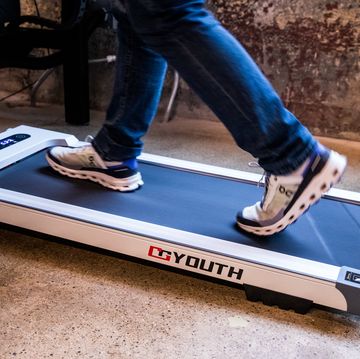The popularity of the 10,000-steps-per-day recommendation originated in the early 1960s with Dr. Yoshiro Hatano, who was concerned about the rise in obesity in Japan. He set out to identify an easy way to track the number of calories burned to help people become more active, lose weight, and improve their health.
He and his research team discovered that if a person increased their daily steps from fewer than 5,000 to 10,000 or more, they would burn approximately 20 percent of their caloric intake through activity, which would lead to weight loss. The concept (and the use of pedometers) then grew in popularity worldwide.
It is important to note that when looking at this formula from a runner’s standpoint, the goal number of steps should vary based on one’s health, weight, fitness, goals, and overall life situation. Here are a few things to consider when counting steps.
If you are a runner who is looking to lose weight and you’re running two to three miles three times per week plus cross-training a few other days, aiming for a total of 10,000 steps per day would be a useful goal in boosting motivation to move and to increase your caloric expenditure to lose weight. In order to achieve your desired goal to lose weight, aiming for the 10,000 average daily step rate without a rest day might be the best approach for you.
If you’re a runner who averages four to six miles three to four times per week plus a few days of high intensity cross-training—and you have a fairly active job that allows you to move around—you are likely hitting more than 10,000 steps on average daily. Because of your overall higher activity level, weaving in a rest day with fewer steps might actually complement your goals for performance and wellness.
However, if you’re a higher-mileage runner but you sit all or most of the day at work, you’re likely reaching the 10,000 steps per day goal—but not in an optimal way. You may actually need more steps to counteract the risks of a sedentary work life (imbalanced posture, injuries due to muscle/joint imbalance, high blood pressure, heart disease). As reported by Amby Burfoot, “according to a research team from the University of Texas Southwest Medical Center, each time unit of sitting cancels out eight percent of your gain from the same amount of running. In other words, if you run for an hour in the morning, and then sit for 10 hours during the day, you lose roughly 80 percent of the health benefit from your morning workout.”
In this case, it would be wise to set a step (or movement) goal for your inactive time at work: things like taking the stairs, pacing when on the phone, taking the long way to the bathroom, scheduling walking meetings, or simply getting up and walking every hour for a few hundred steps. (Here are some other ideas.) Although a complete rest day could allow for optimal recovery, especially if you are on a progressive training plan, getting in regular movement even on your off days could be beneficial. Things like a 20- to 30-minute yoga for runners session or a short walk followed by foam rolling and flexibility work can aid in improving muscle and joint health without adding too much stress to the body to allow recovery from training.
The concept of getting 10,000 steps each day is about inspiring regular movement for weight loss, weight maintenance, and overall health. For a runner, it can be a useful guide you can modify based on your current workout and life schedule.













